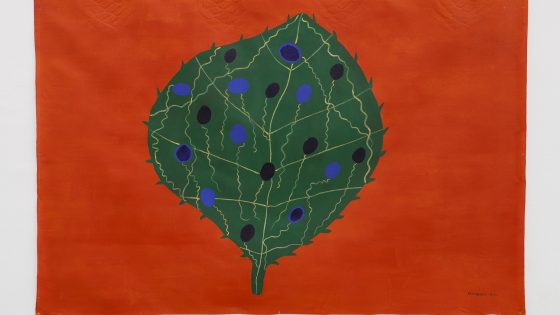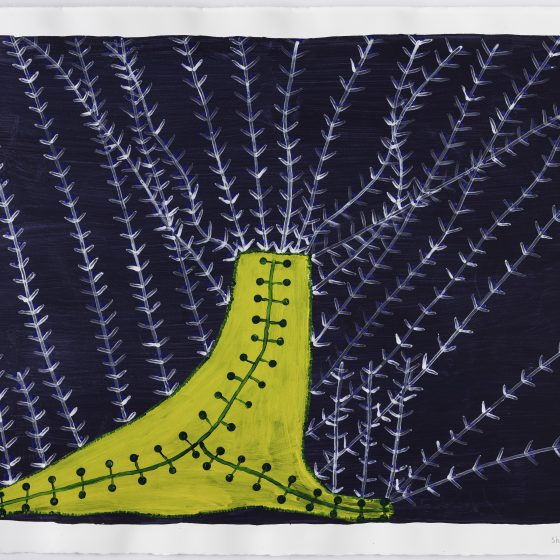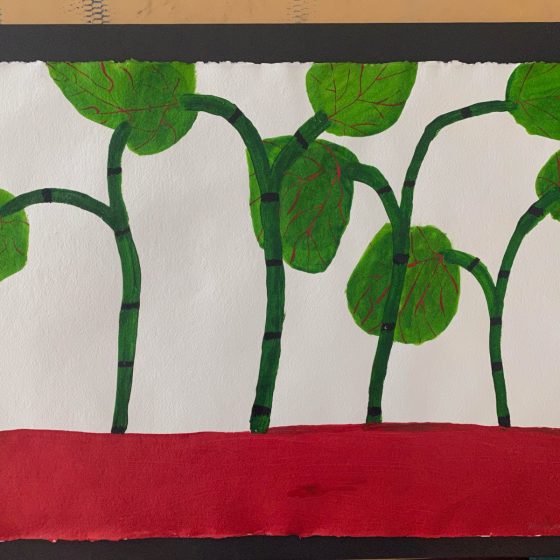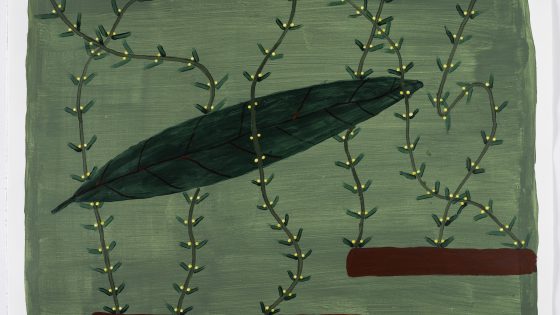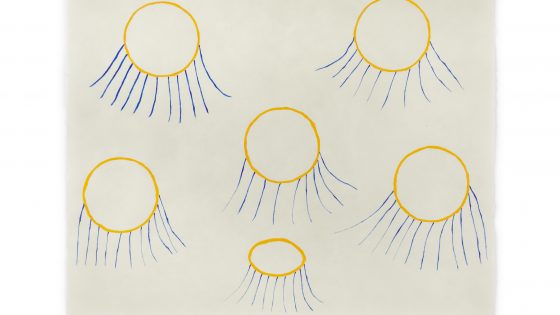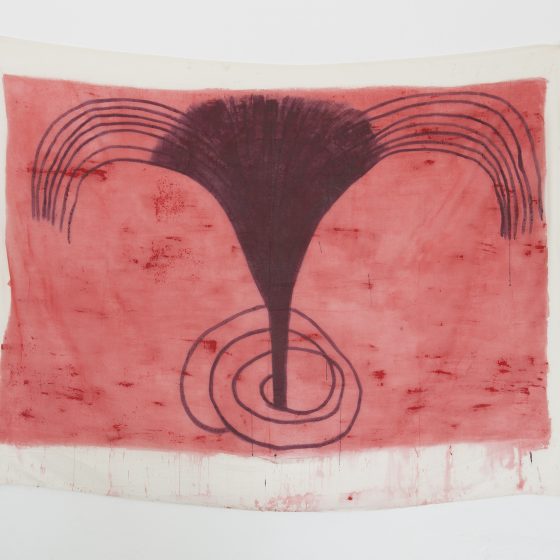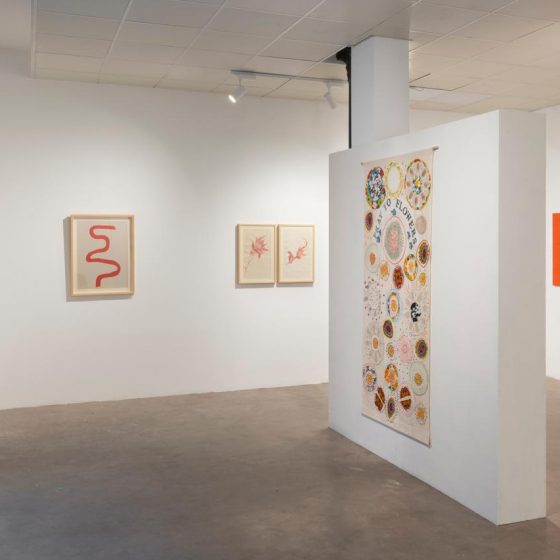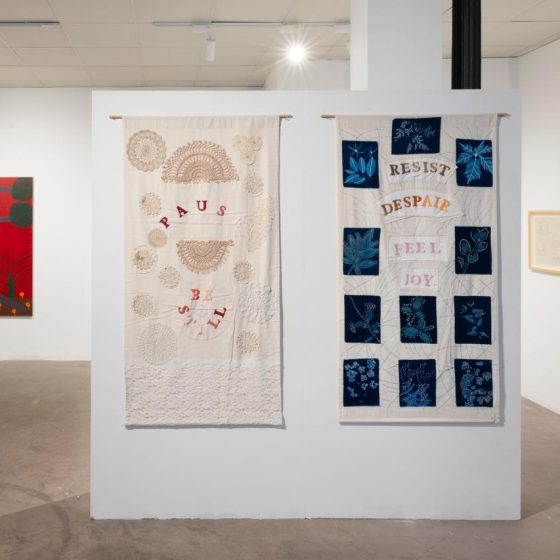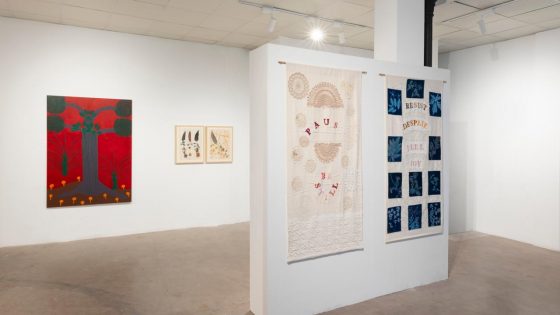MASHITA A RYE EHEWE. Galería Airas Wang de Lafée (AWL).
AWL Airas Wang de Lafée is pleased to present “Mashita a Rye Ehewe”, a dual exhibition by Annalee Davis and Sheroanawe Hakihiiwe in Madrid, Spain. Text by Adriana A. Leanza.
Taking its title from Yanomami vocabulary-where mashita refers to land and rye ehewe means “good for planting”-the exhibition explores the fertility of the land as a vital, living entity. Davis and Hakihiiwe’s practices reflect on the complex relationship between land, memory, and colonial histories, addressing the ongoing impact of extractivist economies and displacement on both the environment and cultural heritage. Curated with words by Adriana A. Leanza, the exhibition invites viewers to reconsider their connection to the natural world through artistic practices that function as both witness and resistance.
Through delicate drawings, collages and mixed media works, Davis’s works examine the violent transformation of Caribbean landscapes under British colonial rule. Using old plantation ledger pages as canvas, his interventions trace the entanglements between monoculture economies and the depletion of soil fertility, proposing acts of reparation and atonement. In parallel, Hakihiiwe’s handmade paper works create a visual lexicon of Yanomami cosmology, preserving oral traditions and indigenous ecological wisdoms. Her depictions of plants, feathers and seeds form an evolving atlas of natural elements, affirming the urihi (forest-earth) as a sacred and interdependent space.
A recurring motif of red-traditionally associated with blood and fertility-is interwoven throughout the exhibition, symbolizing resilience, renewal, and the interconnected pulse between body and earth. Mashita a Rye Ehewe stands as a poetic invocation of place, memory and the permanence of ancestral knowledge, offering a space where art reclaims histories and envisions alternative futures of coexistence and restoration.
Evoking the land’s inherent fertility, the exhibition Mashita a rye ehewe invites us to perceive the forest and its ground as the seed of life. Drawing from Yanomami vision and vocabulary, where there is no distinct separation between the land and the forest, the term urihi designates a cosmological geography, that of the forest-land.
The forest-land is not an inert entity, nor is it entirely subject to the will of human beings. As a living organism, it possesses an essential image, an immaterial fertility principle (mashita a rye ehewe), as well as a vital breath (mishia), responsible for infusing plants and soil with the energy that sustains their essence.
But the colonial expansion and exploitation of Indigenous territories and land, reinforced by the imperialist and extractivist mindset of linear development and progress, revealed a profound rupture between the nape (non-Indigenous peoples) and the very earth that nourishes them, with significant repercussions on the fertility of that land.
The artistic practices of Annalee Davis and Sheroanawe Hakihiiwe within this exhibition acknowledge that any reflection on the land’s fertility is therefore intrinsically tied to the colonial history of violence, displacement and exploitation of Indigenous communities and resources. By reclaiming what remains of these layers of trauma (“The land remembers what we said and what we did”¹) their works are a testament to gestures of 1 preservation and restoration of natural ecosystems, standing as forms of resistance in themselves.
Annalee Davis’s practice examines the entanglements of landscapes violently reshaped by the the British colonial project of sugarcane plantation economy and enslavement in the Caribbean. Through delicate drawings and collages on old plantation ledger pages (Parasite Series, 2017; F is for Frances, 2026), as well as installation pieces (Small sugar cone, study, 2023; Sugarcone-A Motherplot, 2024; How to Know a Land, 2024), the works which comprise In the Sugar Gardens expand on the parasitic relationship between the colonization of the land and the impact on its fertility, encouraging multispecies and intimate connections as healing acts of repair and atonement.
Rooted in ancestral knowledge(s), Sheroanawe Hakihiiwe’s work preserves and renews Yanomami’s cultural, oral heritage. His drawings—created primarily on handmade paper from fibers like sugarcane and cotton—configure a visual glossary of his people’s cosmology. Weaving Indigenous storytelling with artistic abstraction, his compositions celebrate the vibrancy of his community’s traditions, ensuring their endurance for future generations. Through depictions of leaves, feathers, seeds and tree trunks, Hakihiiwe’s works act as an evolving atlas of plants, animals and natural elements. The artist challenges conventional binaries—life and death, human and animal, body and spirit— reasserting the intricate interdependence between humans and the forest-land.
Moving beyond its traditional symbolism of blood and fertility, the colour red weaves through Davis and Hakiwiiwe’s practices and guides us as a luminous thread. It braids stories of persistance, where body and land, water and seed, pulse together in a timeless rhythm of enduring accord.
BIOS
Annalee Davis (Barbados, 1963) embraces her work as a visual artist through a hybrid practice, cultural activism and writing. Her work is situated at the intersection of biography and history, focusing on post-plantation economies through dialogue with a specific Barbadian landscape. Her studio, located on a working dairy farm that in the 17th century operated as a sugar cane plantation, provides a critical context for her work. Through drawing, walking, making bush teas and cultivating living pharmacies, Annalee’s practice proposes future strategies for repair and flourishing, while investigating the role of plants and living spaces as ancestral sites of resistance, alternative knowledge, community and healing.
Sheroanawe Hakihiiwe (Venezuela, 1977) is an indigenous artist residing in Platanal, a Yanomami community in the Upper Orinoco of the Amazonas state of Venezuela. Since the nineties he has been developing a work oriented to the rescue of the oral memory of his people, their cosmogony and ancestral traditions. From the drawing she develops a synthetic, concrete and minimal language about the vast and intense relationship that her community has with the landscape. These links permeate the personal and collective spheres, his work being a contemporary revision of the cosmogony and the Yanomami indigenous imaginary.
Adriana A. Leanza (Sweden, 1994) is a curator, writer and researcher based in London and co-founder of the curatorial collective Allél0n together with María Lucía Marcote García. Born in 2017 as an open digital correspondence experimenting with creative writing and speculative fiction, Allél0n has invited the participation of emerging interdisciplinary researchers, artists and friends called to collective and spontaneous thinking. Adriana has curated exhibitions and non-profit events to support emerging artists at the intersection of sound, visual and performative practice, gaining public funding from Arts Council England National Lottery Project Grants in 2021. Adriana holds a BA in Architecture from the University of Trieste, Italy (2016), an MA in Advanced Studies in Art History from the University of Barcelona, Spain (2018) and an MA in Art Praxis from the Dutch Art Institute, ArtEZ University of the Arts (2023).
GALLERY VISION
AWL Airas Wang de Lafée is a contemporary art space located in Girona that opened its doors on May 5, 2024. The gallery aims to prioritize the voices of artists who sensitively address postcolonial realities and their identity politics, reevaluate traditional processes and collective knowledges; analyze political economies from an anthropogenic perspective; and explore the inherent blurring between the natural and the artificial in post-digitality. We connect the gestures presented in the gallery with their environment, framing them within a vernacular narrative of history, architecture and design, gastronomy, landscape and craftsmanship.
With a careful selection of artists whose works awaken social conscience, we position ourselves as a meeting point for those who seek to understand and confront the challenges of our time. Through creativity, we explore themes such as diversity, equality, social justice and identity, inviting our audiences to reflect on their role in building a more inclusive and compassionate society based on respect and tolerance.
______________________________________________
¹Robin Wall Kimmerer, Braiding Sweetgrass: Indigenous Wisdom, Scientific Knowledge, and the Teachings of Plants, 2013.


